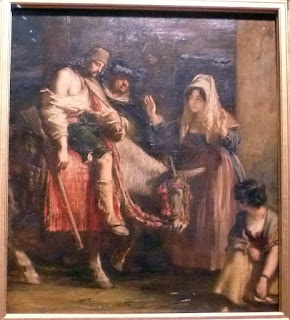The
effect of the Spanish Peninsular war on the 19th century national
consciousness was in some ways similar to our own feelings about battles on the
Western Front during the First World War. Both were part of a much wider
conflict; both were extremely bloody; and both had a huge effect back in Britain.
And,
as always happens in war, stories emerged which caught the public imagination. One of these was the (true) story of the Maid of Saragossa. Readers of Georgette Heyer's The Spanish Bride will remember the scene when Juana intrepidly rides back to their previous lodgings to return a stolen Sevres bowl to its owner. 'Well done, Juana!' exclaims Colonel Barnard. 'You're a heroine. Why, the Maid of Saragossa is nothing to you!'
Wellington's HQ at Ciudad Rodrigo
I
was reminded of all this when I saw the Scottish artist David Wilkie’s paintings of the Peninsular
War in the Royal Collection at the Queen’s Gallery. I’d seen lots of
contemporary prints of the war but not proper oil paintings, so I was
interested to see these.
Wilkie
visited Madrid in 1827 and, inspired by stories of Spanish guerrilla resistance, painted
a series of pictures from the Spanish point of view. It is interesting that
Wilkie chose the Spanish as his subjects. Perhaps he had seen too many returned
British soldiers, wounded and out of work, begging on the streets for him to
want to glamorize them.
The Guerrilla’s Departure by David Wilkie, 1828
The Guerrilla’s
Departure,
painted in 1828, shows a Carmelite monk offering a guerrilla a light for his
cigar. Tobacco smoking was ubiquitous, thanks to the Spanish colonies in Latin
America, and Wilkie’s depiction of an ordinary working man
smoking a cigar must have startled people back home. And was Wilkie, a son
of the manse, also hinting at Roman Catholic intrigue with the monk offering the
guerrilla a light? The church towers up behind them, and a ragged boy sits on
the ground looking up at the scene. A laden donkey waits behind the man.
The
Guerrilla’s Return by David Wilkie, 1828
The
companion picture The Guerrilla’s Return
(1828) shows the returning guerrilla. He arrives ragged and wounded, his left
arm heavily bandaged, slouching on his exhausted donkey, his gun pointing
downwards in a gesture of defeat. There is no church involvement here; this is
personal. A young woman wearing a mantilla, perhaps his wife or sweetheart, holds
up both hands in distress. Behind him we can just glimpse a man who has,
perhaps, helped the guerrilla get home safely. In the front right of the canvas
a kneeling girl looks up.
The
Defence of Saragossa, by David Wilkie, 1828
Wilkie’s
most famous picture The Defence of
Saragossa (1828) takes as its subject the true story of Agustina Zaragoza, ‘the Maid of Saragossa’. In 1808, the
French besieged Saragossa, a city which had not been attacked for four hundred
and fifty years. The local guerrilla leader, Palafox, and the priest Boggiero, another hero of the resistance, seen conferring at the back, have managed to aim a gun at the French. They are ill-equipped and the ramparts are crumbling. How can they hold off the French with
a few ancient cannons? They are heavily outnumbered.
Turret on the ramparts of Ciudad Rodrigo
Behind the cannon, slumped on the floor, is the dying gunner Zaragoza. His wife,
the twenty-two-year-old Agustina, has seen the French bayonets wreaking havoc on the defenders who are losing heart. Heroically, she runs forward, seizes a match and fires the gun at the French at point
blank range, mowing them down. Inspired by her bravery, the fleeing Spanish
rallied to her defence and, together, they beat off the French – at least for a
while.
The ramparts of Santa Lucia.
Wilkie’s
picture of this stirring event is a highly-dramatic one. The cannon is pushed
up against the ramparts by four straining men. Agustina, in a swirl of white
and pink drapery, holds the lighted taper aloft, ready to fire the cannon.
Behind her, pressed against the ruined city wall, Palafox talks to Boggiero.
Agustina's
story quickly spread. Byron depicts her in the first canto of Childe Harold's Pilgrimage. Here, she is inflamed by
the sight of her lover mown down by the French.
Her lover sinks—she sheds no ill-timed
tear;
Her chief is slain—she fills his fatal
post;
Her fellows flee—she checks their base
career;
The foe retires—she heads the sallying
host:
Who can appease like her a lover's ghost?
The French, as Byron
puts it, are: ‘Foiled by a woman's hand, before a battered wall.’ This extract comes from Canto 1, published in 1812 while the Peninsular War still raged.
After her heroism at Saragossa,
Agustina became a rebel with the guerrilleros helping to harass the French
and it's good to know that she lived to a ripe old age. Interestingly, Byron actually met Agustina some years after he wrote Childe
Harold.
Bridge over the River Coa, she scene of
fierce fighting
Many of us who
write Regencies have sent our characters to the killing fields of the
Peninsular War. Indeed, I’ve done so myself. So I thought you might enjoy a
glimpse of a different take on the subject with David Wilkie’s vivid paintings.
If you’d like to
see the paintings for yourself, they in the Scottish
Artists 1750-1900: from Caledonia to the Continent exhibition at The Queen’s
Gallery until 9 October, 2016
Other photos
by Elizabeth Hawksley
Elizabeth
Hawksley




















